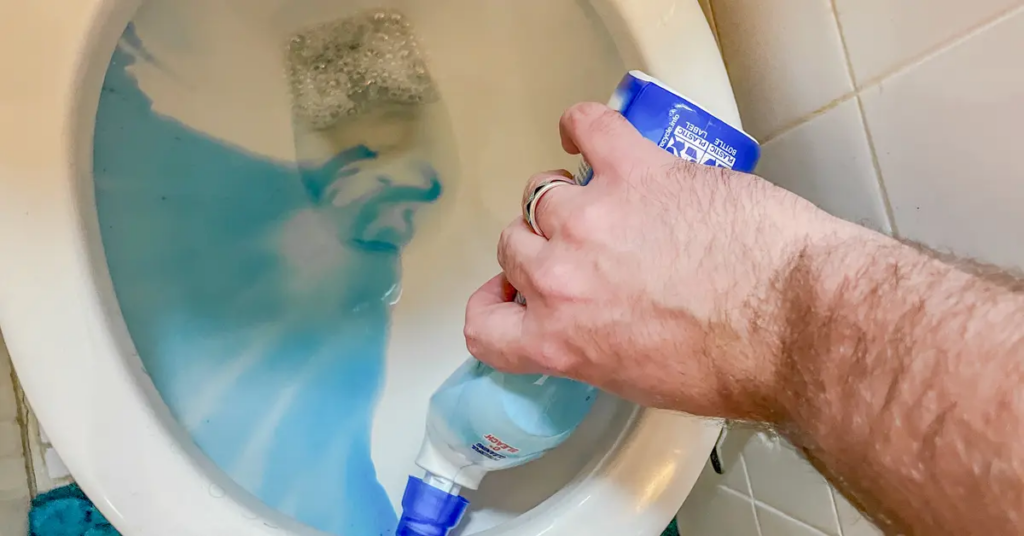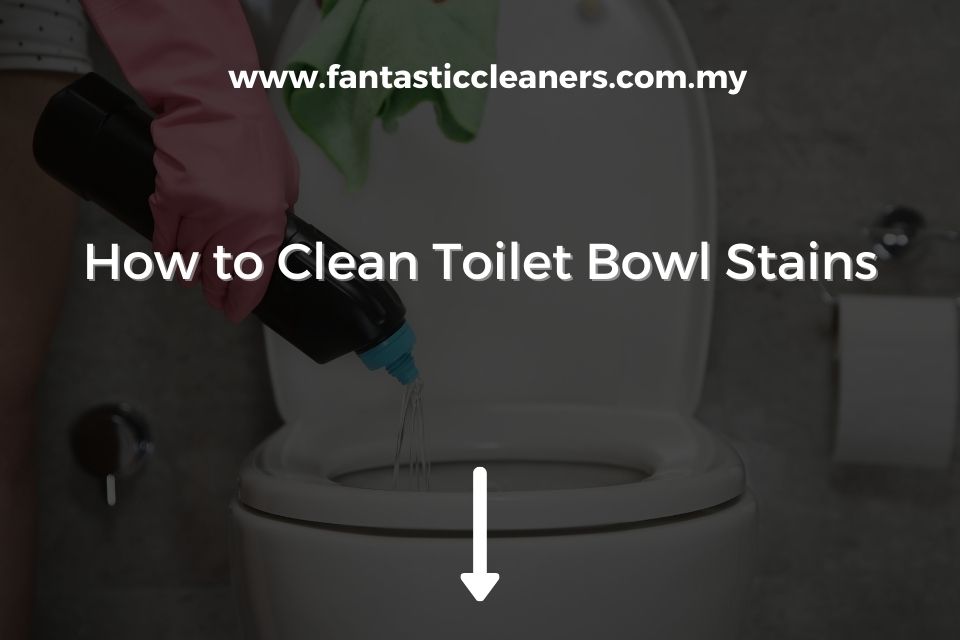Tired of those unsightly stains in your toilet bowl? Worry no more! Discover how to efficiently eliminate those dreadful stains and achieve pristine results with this guide from Fantastic Cleaners. Transform your bathroom and bring back its radiant splendor!
Table of Contents
Use a Toilet Bowl Cleaner

Using a specialized toilet bowl cleaner is the best way to remove most toilet bowl stains. Choose an appropriate cleaner for the type of material in your toilet; keep in mind that a bleach-based cleaner should never be used on colored porcelain or any type of acrylic.
Use a brush or an extended-reach applicator incase you are unable to access the inside of the bowl with your hands. Apply evenly over the stained areas and allow product to sit for 8-10 minutes, then scrub away with a toilet brush and flush toilet afterwards. Continue flushing until all product is removed from inside bowl.
Scrub the Bowl

To remove stains from your toilet bowl, start by giving it a good scrub. Gather your supplies: gloves, a stiff-bristle brush, a toilet bowl cleaner and a clean rag.
- Start by using the cleaner to break down the stains. Apply it onto the affected area generously and let it sit for a few minutes before scrubbing with the brush.
- Be sure to scrub as deeply along the rim and crevices of the bowl as you can; this will loosen any ingrained dirt, mineral deposits and debris that have built up over time.
- Once you are done cleaning, run some water into the bowl and use your toilet brush to make sure that everything has been removed.
- Finally, take your clean rag and wipe down any remaining residue from around the edges of the bowl.
Use a Pumice Stone

A pumice stone is a volcanic rock with a rough, abrasive surface that can be used to remove tough stains from toilet bowls. It works best on mineral deposits and rust stains, which may be caused by elevated levels of minerals in the water or the age of your porcelain bowl. For stubborn stains, it’s best to wet the stone before scrubbing and let it sit for a few minutes to soften up the build-up.
Follow these steps for using a pumice stone to clean your toilet bowl:
- Put on household gloves and wet the pumice stone under warm water.
- Gently scrub the inside of the toilet bowl with the pumice stone in a circular motion, focusing on stained areas specifically.
- Let the stone sit in place for one to two minutes and then continue scrubbing in small circles until you start to see black or gray residue coming off on the cloth or sponge used as backup cleaning tool.
- Continue until all stains have been removed from the bowl with additional rinsing of your cloth or sponge if needed between each stroke.
- Discard any excess water from your cleaning accessory, dry with terry cloth towel, and flush toilet before finishing.
Try Vinegar and Baking Soda

Using vinegar and baking soda is an effective and safe way to clean toilet bowl stains with natural products. Vinegar is a mild acid which can break down hard water deposits, while baking soda is a powerful base that helps to clean without causing corrosion. Cleaning the toilet bowl with this combination of ingredients will leave it looking fresh and new.
The steps for cleaning your toilet bowl with vinegar and baking soda are as follows:
- Begin by flushing the toilet, so that the cleaning solution gets access to the entire bowl.
- Pour a cup of white vinegar into the bowl and allow it to sit for 10-20 minutes. If possible, scrub away any tough spots with a brush during this time.
- After letting the vinegar sit, pour in 1/4 cup of baking soda and gently stir it around with a brush to coat all sides of the bowl evenly. The mixture should begin fizzing immediately due to an acid-base reaction between the two ingredients.
- Once you have finished stirring or scrubbing, let the mixture sit in the bowl for 10 minutes before flushing the water away completely and refilling it again with cold or warm water (whichever is applicable).
- Then using a cloth, sponge or toilet brush get rid of any residue from around edges inside of your toilet’s rim area as well as beneath its lid in order to ensure that no remaining debris clogs up the plumbing system near future use! In addition, use another cloth to dry off any excess liquid on outer surfaces such as seats or seat covers (excluding these helps prevent mildew formation).
Use a Commercial Rust Remover
Using a commercial rust remover is one of the most effective ways to remove toilet bowl stains. It is important to use a rust remover specifically designed for toilets, as other products may damage surfaces or cause unintended harm.
To use a rust remover, first put on gloves and safety glasses. Next, pour the product directly onto the stain in the toilet bowl and allow it to sit for 1-2 minutes. After a few minutes, flush the toilet several times to rinse away any product that did not react with the stain. If there are still some stubborn stains remaining, you may need to repeat this process another time or scrub away remaining residues with a toilet brush.
Be sure to read all manufacturer instructions and safety warnings before beginning this process and never mix different cleaning products as it can be hazardous or cause skin irritation. Additionally, you should always wear protective clothing and ventilate your restroom area well when using commercial cleaners.
Prevent Future Stains
To help prevent future stains in your toilet bowl, start by regularly cleaning the inside surface of the bowl with a disinfectant cleaner or white vinegar to keep dirt and grime from building up. You should clean your toilet twice weekly and after every use, especially if someone has been ill.
It’s also a good idea to rinse off the brush after each scrubbing so you aren’t transferring germs around the bathroom. Regularly swish plain water around in your toilet using a toilet brush and leave this mixture in there for 15 minutes before flushing it out to help dissolve any soap scum that may have accumulated on the surface.
Additionally, you could try installing a ‘bathroom buddy’ system – a piece of equipment located over your toilet tank that adds additional bacteria-fighting chemical agents into each flush for extra protection against dirt and grime. Finally, adding an absorptive tablet or chlorine bleach disc into the tank can help get rid of stains early on before they become permanent fixtures.
Conclusion
Having a clean and unstained toilet bowl is essential for maintaining overall hygiene in the home and workspace. You now have the knowledge and tools you need to tackle almost any type of stain that might occur in your toilet, from rust or hard water stains to tough yellow build-up.
Don’t forget to use protective gloves when handling harsh chemicals, stay safe! Regular cleaning with mild disinfectants and gentle toilet cleaners will help you avoid future staining. Make sure you clean your bathroom regularly to prevent any future problems with stained toilet bowls.
Frequently Asked Questions
What is the best way to remove toilet bowl stains?
The best way to remove toilet bowl stains is to use a combination of white vinegar and baking soda. Pour 1/2 cup of white vinegar into the bowl, then sprinkle 1/2 cup of baking soda around the rim of the toilet bowl. Let it sit for at least an hour, then scrub the bowl with a toilet brush and flush.
How can I prevent toilet bowl stains?
To prevent toilet bowl stains, you should clean your toilet bowl regularly. Use a toilet brush to scrub the bowl after every use, and use a toilet bowl cleaner each time you clean. Also, make sure to flush the toilet after each use to help keep the bowl clean.
What should I do if the stains won’t come off?
If the stains still won’t come off after you have tried cleaning with vinegar and baking soda, you can try using a stronger cleaner such as bleach or a commercial toilet bowl cleaner. Make sure to wear gloves and follow the directions on the label.

